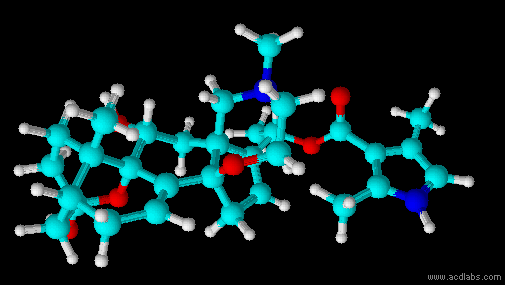> Home > Batrachotoxin (BTX) Prod.N# L8301
Batrachotoxin (BTX), Prod. No L8301
A strong sodium channel activator
Batrachotoxin is an alkaloid with a steroid skeleton and an oxazapine ring,
and a dimethylpyrrole carboxylate moiety. Purified from skin extract of the poison dart frog Phyllobates terribilis.
Biological activity :
BTX is the most active alkaloid binding at receptor site-2 on sodium channels. It activates the sodium channel even at very negative membrane potentials and keeps it open permanently by preventing channel inactivation. BTX also changes the selectivity of the channel to Na+ ions and makes it less selective, enabling larger ions to pass through the pore. EC50 (in vitro): 0.1 to 100 nanomolar.
BTX binding induces many allosteric effects on other channel regions, and increases the binding of scorpion alpha-toxins to receptor site-3, of brevetoxin to receptor site-5, and of pyrethroid insecticides to receptor site-7.
Field of use :
Batrachotoxin-sensitive sodium channels are expressed in central and peripheral neurons and in both striated and cardiac muscle, where they regulate excitability. A number of channel subtypes exist. Research tool applicable to the study of the function of sodium channel and the effects of other toxins and of a variety of drugs, including anesthetics, analgesics, antiarrhythmics, anticonvulsants and antidepressants.
Recommended doses: < 1 microgram/kg
Recommended concentrations: 0.01 to 10 micromolar.Purity : min. 90 %. (HPLC, TLC, Toxicity)
Toxicity (LD50) :
Mice (sc): LD50: 2 micrograms/kg. Convulsions and death after 8 min at 10 micrograms/kgStorage and reconstitution recommendations :
Stable at room temperature, store preferably at 4°C. Solid and solutions can be kept in deep freeze for a long time without any change in their activity. Reconstitution: dissolve in ethanol or methanol.Safety recommendations : Highly toxic.
Bibliographic references :
1. T. Tokuyama et al, J. Am Chem. Soc 91:3931 (1969)
2. E. X. Albuquerque et al, Science 172:995 (1971)
3. W. A. Catterall et al, J. Biol. Chem. 256:8922 (1981)
4. T. Tokuyama and J.W. Daly, Tetrahedron 39:41-47 (1983)
5. G.B. Brown, Internat. Rev. Neurobiol. 29: 77-116 (1988)
6. M. Kurosu et al., J. Am Chem.. Soc. 120: 6629 (1998)
7. S. J. Wang and G. K. Wang, Cellular Signaling 15: 151 (2003)
8. Batrachotoxin. RN 23509-16-2. STN Registry file (27 February 2006)External Links : Batrachotoxin on PubMed

Move your mouse over the structure for 3D view
| CHEMICAL PROPERTIES | |
Chemical Names |
BTX; Batrachotoxin (7CI, 8CI); Batrachotoxinin A, 20-(2,4-dimethyl-1H-pyrrole-3-carboxylate). |
| Structure | C31H42N2O6 |
CAS No. |
23509-16-2 |
| RTECS No. | CR3990000 |
| Merck Index No (13th Ed.) |
1012 |
| PHYSICAL PROPERTIES | |
Molecular Weight |
538.67 |
Physical Form |
film |
Predicted Density |
1.34 +/- 0.1 g/cm3 |
Melting point |
decomposes |
Solubility |
Soluble in ethanol, methanol and DMSO |
Predicted pKa (25 °C) |
7.1 to 8.0. |
Optical activity |
__29 [α]300 − 260° (c = 0.23 in methanol) |
| PACKAGING AND PRICES | |
10 µg
20 µg
100 µg
Also available in milligrams (on request). |
For prices or to place an order, please go to our website. Shipment within 5 days upon receipt of your order. For shipment outside the EEC, export CITES permit required (usually 1 to 3 weeks). |

Copyright © Latoxan SAS, 2007
http://www.batrachotoxin.com
Venoms - Toxins - Alkaloids - Plant Compounds - Ion Channel & Receptor Ligands LATOXAN SAS - 20, Rue Léon Blum 26000 Valence - France Phone : (+33) 47 541 9191 Fax : (+33) 47 541 91 99 |